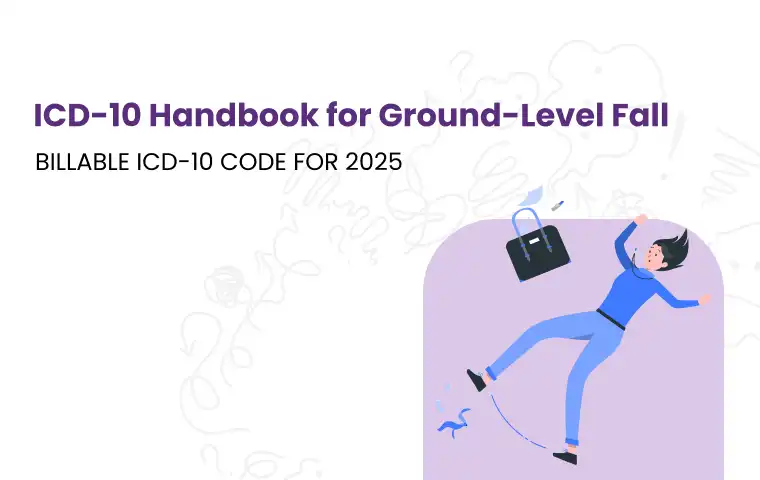Every day, people experience ground-level falls—it's more common than you might think. But when coding these incidents in healthcare, things can get confusing. That's why we've created "The Complete ICD-10 Handbook for Ground-Level Fall Incidents." We'll walk you through the number of related icd 10 codes for ground-level falls of every type.
Billable ICD-10 Code for Ground-Level Falls
Ground-level falls are common incidents that can lead to a variety of injuries, especially among older adults. Accurately documenting these events during the initial encounter is essential for effective patient care, appropriate billing, and data collection for public health statistics.
Understanding Ground-Level Falls in Initial Encounters
An initial encounter refers to the first time a healthcare provider assesses and begins treatment for a patient's injury or condition resulting from a specific incident. In the context of ground-level falls, this means documenting the patient's first visit related to the fall and any associated injuries.
Key ICD-10 Codes for Ground-Level Falls
When coding for ground-level falls, the following ICD-10 codes are commonly used:
-
W18.30XA - Fall on same level, unspecified, initial encounter
This code is used when a patient falls on the same level (not from a height) but the specifics of how the fall occurred are not detailed. -
W19.XXXA - Unspecified fall, initial encounter
Use this code when the details of the fall are unknown or not specified in the medical record.
The "A" at the end of these codes signifies that this is the initial encounter for the treatment of the injuries resulting from the fall.
Documenting the Initial Encounter
To ensure accurate coding and optimal patient care, documentation during the initial encounter should include:
Detailed Description of the Fall
-
How the Fall Occurred: Include specifics such as tripping over an object, slipping on a wet surface, or losing balance.
-
Location: Note where the fall occurred—at home, in a public place, at work, etc.
-
Activity at the Time of Fall: Document what the patient did when they fell, if relevant.
ICD 10 Codes for Fall On Same Level Due to Collision With Another Person
When a patient experiences a ground-level fall due to colliding with another person, it's important to document this specific circumstance during the initial encounter.
The specific ICD-10 code for this scenario is:
-
W03.XXXA - Other fall on same level due to collision with another person, initial encounter
-
W03: Identifies a fall on the same level due to collision with another person.
-
XXX: Placeholders that allow the code to reach the required seven characters.
-
A: Indicates that this is the initial encounter for active treatment of the injury
-
ICD 10 Codes for Fall From Slipping, Tripping and Stumbling
This category covers incidents where a person falls on the same level due to slipping, tripping, or stumbling, whether or not they subsequently strike an object.
1. W01.0XXA - Fall on Same Level from Slipping, Tripping, and Stumbling Without Subsequent Striking Against Object, Initial Encounter
-
W01: Fall on same level from slipping, tripping, and stumbling.
-
.0: Indicates that there was no subsequent striking against an object after the fall.
-
XX: Placeholders required to expand the code to seven characters.
-
A: Denotes the initial encounter, meaning it's the first time the patient is being seen for this injury.
Scenario Covered: This code is used when a patient slips, trips, or stumbles and falls on the same level without hitting any object during or after the fall.
Example: A person walks on a wet floor, slips, and falls but does not hit any furniture or objects on the way down or after landing.
2. W01.1XXA - Fall on Same Level from Slipping, Tripping, and Stumbling With Subsequent Striking Against Object, Initial Encounter
-
W01: Fall on same level from slipping, tripping, and stumbling.
-
.1: Indicates that there was subsequent striking against an object after the fall.
-
XX: Placeholders.
-
A: Initial encounter.
Explanation:
-
Scenario Covered: This code is used when a patient slips, trips, or stumbles and falls on the same level and then hits an object during or after the fall.
-
Example: A person trips over a rug, falls, and hits their head on a table.
ICD-10 Codes for Falls with Fractures and Other Injuries
When a patient experiences a fall that leads to fractures or other injuries, two main types of ICD-10 codes are used:
-
Injury Codes (S Codes): These codes describe the specific injuries sustained, such as fractures, dislocations, sprains, and contusions.
-
External Cause Codes (W Codes): These codes detail the circumstances of the fall, explaining how and where the injury occurred.
1. Injury Codes (S Codes)
Injury codes are found in Chapter 19: Injury, Poisoning, and Certain Other Consequences of External Causes (S00-T88) of the ICD-10-CM manual. They provide detailed information about the injury's nature and location.
Fracture Codes
Fracture codes are categorized by the specific bone and location of the fracture. Key factors to include when coding fractures:
-
Anatomical Site: Specify the exact bone and part of the bone fractured.
-
Type of Fracture: Indicate whether it's open or closed, displaced or non-displaced.
-
Laterality: Note whether the injury is on the left or right side.
-
Encounter Type: Use the appropriate 7th character to denote the encounter type.
Example of Fracture Codes:
-
S72.001A - Fracture of unspecified part of neck of right femur, initial encounter for closed fracture
-
S52.501A - Unspecified fracture of the lower end of right radius, initial encounter for closed fracture
Other Injury Codes
-
Dislocations (S03, S13, S33, etc.)
-
Sprains and Strains (S13, S16, S23, S33, etc.)
-
Contusions (S00-S09 for head, S10-S19 for neck, etc.)
-
Lacerations (S01 for head, S11 for neck, etc.)
Ensure each injury code is as specific as possible, detailing the exact nature and location of the injury.
2. External Cause Codes (W Codes)
External cause codes are found in Chapter 20: External Causes of Morbidity (V00-Y99). They explain the circumstances surrounding the injury, such as how the fall happened.
Common External Cause Codes for Falls
-
W01.0XXA - Fall on same level from slipping, tripping, and stumbling without subsequent striking against object, initial encounter
-
W01.1XXA - Fall on same level from slipping, tripping, and stumbling with subsequent striking against object, initial encounter
-
W18.30XA - Fall on same level due to collision with another object, initial encounter
-
W19.XXXA - Unspecified fall, initial encounter
Note: The 7th character 'A' indicates an initial encounter.
Place of Occurrence Codes (Y92)
These codes provide information about where the fall occurred:
-
Y92.009 - Unspecified place in unspecified residence as the place of occurrence of the external cause
-
Y92.030 - School dormitory as the place of occurrence of the external cause
-
Y92.511 - Bathroom of single-family (private) house as the place of occurrence
Activity Codes (Y93)
Activity codes describe what the patient was doing at the time of the injury:
-
Y93.01 - Activity, walking, marching, and hiking
-
Y93.02 - Activity, running
-
Y93.89 - Other specified activities
Coding Guidelines and Sequencing

Primary Diagnosis (Injury Code):
Sequence the injury code first (e.g., fracture code).
Multiple Injuries: If there are multiple injuries, list the most severe or the one requiring the most immediate attention first.
External Cause Codes:
Sequence external cause codes after injury codes.
They provide context but are not primary diagnoses.
Place of Occurrence and Activity Codes:
Optional but Recommended: These codes offer additional details that can be valuable for data analysis and preventive measures.
Use of 7th Character Extensions:
Fractures: Use appropriate 7th characters (e.g., 'A' for initial encounter, 'D' for subsequent encounter, 'S' for sequela).
Non-Fracture Injuries: Use 'A', 'D', or 'S' as applicable.
Placeholder 'X':
Use 'X' as a placeholder to fill empty character spaces when a code requires a 7th character but does not have six characters.
Examples of Coding Falls with Fractures and Other Injuries
Example 1: Fall Resulting in a Hip Fracture
Scenario: An elderly patient falls at home while walking to the kitchen, resulting in a closed fracture of the neck of the left femur (hip). This is the initial encounter.
Codes:
-
Injury Code:
-
S72.002A - Fracture of unspecified part of neck of left femur, initial encounter for closed fracture
-
-
External Cause Code:
-
W19.XXXA - Unspecified fall, initial encounter
-
-
Place of Occurrence:
-
Y92.010 - Kitchen of single-family (private) house as the place of occurrence
-
-
Activity Code:
-
Y93.01 - Activity, walking
-
Example 2: Fall with Wrist Fracture Due to Tripping
Scenario: A middle-aged woman trips over a curb while jogging in the park and falls, sustaining a closed fracture of the right distal radius (wrist). Initial encounter.
Codes:
-
Injury Code:
-
S52.501A - Unspecified fracture of the lower end of right radius, initial encounter for closed fracture
-
-
External Cause Code:
-
W01.0XXA - Fall on same level from slipping, tripping, and stumbling without subsequent striking against object, initial encounter
-
-
Place of Occurrence:
-
Y92.830 - Public park as the place of occurrence
-
-
Activity Code:
-
Y93.02 - Activity, running
-
Example 3: Fall Resulting in Head Injury and Laceration
Scenario: A construction worker falls from scaffolding at a construction site, resulting in a concussion with loss of consciousness of less than 30 minutes and a deep laceration on the forehead. Initial encounter.
Codes:
-
Injury Codes:
S06.0X1A - Concussion with loss of consciousness of 30 minutes or less, initial encounter
S01.81XA - Laceration without foreign body of other part of head, initial encounter
-
External Cause Code:
W12.XXXA - Fall on and from scaffolding, initial encounter
-
Place of Occurrence:
Y92.61 - Construction site as the place of occurrence
-
Activity Code:
Y93.H9 - Activity, other specified work-related activity
Final Words
Accurately coding ground-level falls using ICD-10 is essential for effective patient care, proper billing, and valuable public health data. By thoroughly understanding and applying the appropriate codes for different fall scenarios and associated injuries, healthcare professionals can ensure precise documentation. This not only enhances treatment outcomes but also contributes to broader efforts in injury prevention and healthcare resource planning.
ABOUT AUTHOR

Pedro Collins
As a blog writer with years of experience in the healthcare industry, I have got what it takes to write well-researched content that adds value for the audience. I am a curious individual by nature, driven by passion and I translate that into my writings. I aspire to be among the leading content writers in the world.
